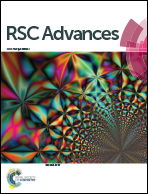Unraveling the physical chemistry and the mixed binding modes of complex DNA ligands by single molecule stretching experiments
Abstract
In this work we present a complete methodology to unravel the physical chemistry and the mixed binding modes of complex DNA ligands. Single molecule stretching experiments were performed with complexes formed between a DNA binding drug that exhibits multiple mixed binding modes (Berenil) and the biopolymer. From these experiments we determine the changes of the two basic mechanical properties, the contour and persistence lengths, as a function of the drug concentration in the sample. Combining a modeling analysis for the two mechanical properties, we were able to extract the physicochemical parameters of the interaction and to determine the effective binding mechanisms. In particular, we have shown that in this case the binding modes can be modulated by changing the ionic strength of the surrounding buffer: for high ionic strengths (150 mM), Berenil behaves as a typical minor groove ligand in its interaction with λ-DNA; while, for low ionic strengths (10 mM), the drug also partially intercalates into the double-helix. The methodology developed in the present analysis can be promptly applied to other complex DNA ligands, therefore allowing one to investigate and decouple different binding mechanisms.


 Please wait while we load your content...
Please wait while we load your content...